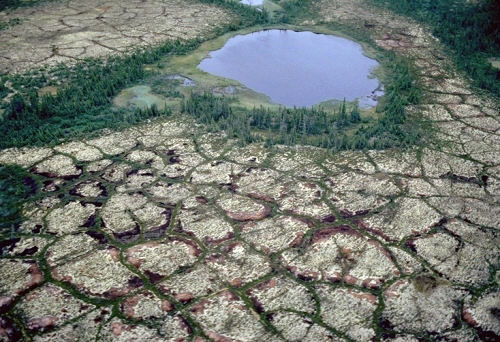Following
on from the previous post on glacial processes, the next thing to look at are
the glacial landforms that occur as a result of these processes. Due to the
forceful action of erosion and weathering, the landscape through which the
glacier moves is left looking very different to many other landscapes created
from erosional and weathering processes.
There
are two different types of landform that are created from glaciers: erosional and
depositional.
First of all I will start by
looking at erosional landforms.
Corries (also
known as cwms or cirques) are found at the top of the mountain
where the glacier first begins. They are bowl-shaped hollows which form as a
result of plucking, abrasion and freeze-thaw action as the glacier moves further
down the mountain or valley. If the ice within a corrie melts, a lake often
forms and this is known as a tarn.
U-shaped valleys form as a result of a glacier moving down the
valley. Glaciers usually follow the path of old river beds and so the glacier
continues to erode the v-shaped river valley, cutting through harder rock that
the river could not erode and thus creates a much wider U-shaped valley. Characteristically
they have a flat floor with steep sides. Glaciers are also much like rivers in
that when they erode through the upper course of the glacier, they leave behind
truncated spurs
(on a river they are known as interlocking spurs).
Arêtes are sharp, knife edge, ridges of rock which form when two corries
form back to back. Each glacier continues to erode either side of the strip
between the two corries which eventually leads to the creation of a very steep
and narrow ridge.
Pyramidal peaks form as a result of the meeting of 3 or more
corries and arêtes. The continued erosion eventually leads to the formation of
a pyramidal peak (also known as a horn).
Diagram illustrating the above erosional land forms
Ribbon lakes form as a result of the erosion by the glacier on
the valley floor. As it flows
over this land, softer rock erodes much quicker
and easier as opposed to hard rock and so the glacier creates deeper troughs in
the soft rock. When the glacier has retreated, water will begin to collect in these
deep troughs and can create long, thin, ribbon lakes.
Crag and tail also forms as a result of the differential erosion
of the soft and hard rock over which a glacier flows. As the glacier flows over
soft rock it eventually hits an area of hard rock and so instead of cutting
right through it, it goes over the hard rock. This area of hard rock protects
the softer rock behind it, creating a crag and tail. One good example of a crag
and tail is Edinburgh
castle.
Diagram illustrating a crag and tail (BBC Bitesize)
Now
that I have finished looking at the erosional landforms created by glaciers, I
am going to move on to looking at the depositional landforms.
Till, also known as boulder clay, is the debris that is deposited
when a glacier has retreated and is made up of a variety of material, including
rock, sand, gravel and mud.
Moraines are deposits that have previously been carried by
a glacier and dropped as the glacier retreats. There are four different types
of moraine:
Terminal – found at the furthest point that was
reached by the glacier
Lateral – found along the sides of the glacier
Medial – found at the place where two glaciers have
joined together to create one, larger,
glacier
Ground – variety of sizes and types of rock found
at the bottom of the glacier
Not
all material that was once carried by the glacier is deposited as a moraine.
Material is sometimes carried by the melt water streams and is deposited as it
flows. As a result, after many years of this small, steep mounds of debris
accumulates adjacent to the glacier, known as kames.
Erratics are large, unsorted boulders that are deposited
once a glacier has retreated. As they are so large they are often found
individually, and not in piles and are often of a different rock to that of the
surrounding area.
Drumlins are large, long hills which are created as a
result of glacial deposits. Although there is much disagreement on how
precisely they were formed, it is thought that they were created when
subglacial material that had accumulated from various erosive and weathering
processes was deposited. As the drumlins are shaped by glacial movement, all of
those created by the same glacier face in the same direction; running parallel
to the flow of the glacier.
Diagram above illustrates the above depositional landforms
As
has been the case with other areas that I have already covered within this
glacial topic, I think it is important to incorporate imagery into the
teaching. Visual aids help to show pupils what they are learning and it could
be easier for them to remember the different terms if they have been able to
see it. Another way to help the learning of these terms would be to hand out a
diagram of a glacier valley and ask students to add the labels for the
different landforms created.
BBC
Bitesize as well as National Geographic have been very useful with this area
and are filled with useful pictures, diagrams and resources which could prove
to be very useful!
Links
used:













